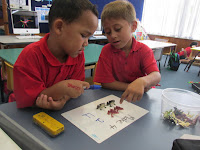Problem that I launched:
There were 18 children in a bus. At the bus stop 4 children hopped on. How many children in the bus now?
I had a group of 6 children and they were paired with a partner. Each pair was given a blank paper.
Don suggested I give them counters and a pencil to show/write down their thinking. I read the word problem and talked about it making it a real life story (picture this in your head, imagine). Don asked to me ask the children ”Do we know what we are trying to find out?” One child said “How many children in the bus.” Other children in the group had to repeat ” We are finding out how many children in the bus altogether?” Children had to work with their partners and then share back to the group. Findings: It was interesting to observe and notice behaviours of the children in that group (social interaction with each other). Some worked together as a team, made certain that they took turns. Another pair worked on the problem by themselves whilst the other two children just played with the counters. It was really difficult to sit back and watch without talking as much. Don said to praise children who are taking turns, talking to each other, telling one another what they doing, telling someone that they cannot hear him/her or to repeat what they said. We also worked on unpacking the vocabulary in the word problem. One child made 18 children using counters and took away 4 counters. We talked about what hoped on meant. They made 18 children and 4 children but then did not understand what altogether meant.
My focus over the next few weeks is:
Conversation.
I need to create opportunities in my class where children can have these conversations. Children need to start talking to each other about their learning, thinking, problem solving. I also need to work on selecting problems that are of interest to the children for example: instead of using bus stop I could say for example: How many children at church, or in the pool, on the field. I need to find out what about my pupils likes and interests which will then lead to engagement. I also need to ensure that they understand the word problem, the language, unpack and scaffold mathematical terms and language and words for example: altogether, hopped in, left over, share evenly/equally.
Don suggested:
-We do our planning as a team and work collaboratively.
-When working on an activity on the iPad-work in pairs- increase confidence to talk and have --conversations with each other. Record children’s learning making it re-windable. Share on Apple T.V. and blog.
My next steps:
-Encourage children to have conversations, they can work in pairs, groups to complete tasks, read your PM reader to a friend, retell them the story in your own words.
-Continue to work on scaffolding mathematical language.
-Continue to talk to my colleagues, get some ideas of what they doing with their children and do some research.




